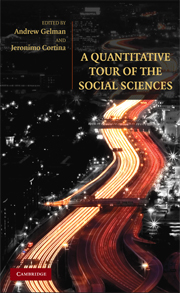Book contents
- Frontmatter
- Contents
- Preface: Learning to Think Like a Social Scientist
- About the Contributors
- PART I MODELS AND METHODS IN THE SOCIAL SCIENCES
- PART II HISTORY
- PART III ECONOMICS
- PART IV SOCIOLOGY
- PART V POLITICAL SCIENCE
- 15 What Is Political Science?
- 16 The Politics of Supreme Court Nominations: The Critical Role of the Media Environment
- 17 Modeling Strategy in Congressional Hearings
- PART VI PSYCHOLOGY
- PART VII TO TREAT OR NOT TO TREAT: CAUSAL INFERENCE IN THE SOCIAL SCIENCES
- References
- Index
16 - The Politics of Supreme Court Nominations: The Critical Role of the Media Environment
Published online by Cambridge University Press: 05 June 2012
- Frontmatter
- Contents
- Preface: Learning to Think Like a Social Scientist
- About the Contributors
- PART I MODELS AND METHODS IN THE SOCIAL SCIENCES
- PART II HISTORY
- PART III ECONOMICS
- PART IV SOCIOLOGY
- PART V POLITICAL SCIENCE
- 15 What Is Political Science?
- 16 The Politics of Supreme Court Nominations: The Critical Role of the Media Environment
- 17 Modeling Strategy in Congressional Hearings
- PART VI PSYCHOLOGY
- PART VII TO TREAT OR NOT TO TREAT: CAUSAL INFERENCE IN THE SOCIAL SCIENCES
- References
- Index
Summary
In this chapter and the next, we'll work through an extended empirical political analysis involving the politics of Supreme Court nominations. I'll present this material in approximately the way the analysis took place, rather than in the cleaned-up and artificially neat way one presents it in a seminar or paper. I'll begin by reviewing an earlier study on how senators vote on Supreme Court nominations. The voting analysis raises a puzzle, apparently concerning the choices presidents make when they select nominees. But, as we shall see, the puzzle isn't really about presidents at all. Rather, the puzzle involves how the news media portray nominees and (ultimately) how hostile members of the Judiciary Committee manipulate the media environment in order to damage nominees. Or so I claim.
The point of these chapters is to show how a real analysis unfolds, which takes place in a way that is quite different from what one might think after reading journal articles or scholarly books. So, as we go, I'll discuss some personal background, the places where I was stumped, how luck entered in, where the ideas came from, and how I dealt with measurement issues. I'll also make comments about various statistical techniques and choices. The following chapter will consider the interplay of theory and data as well.
THE SPATIAL MODEL OF VOTING
We start with the basic model that political scientists use to describe voting based on issue positions.
- Type
- Chapter
- Information
- A Quantitative Tour of the Social Sciences , pp. 223 - 241Publisher: Cambridge University PressPrint publication year: 2009



